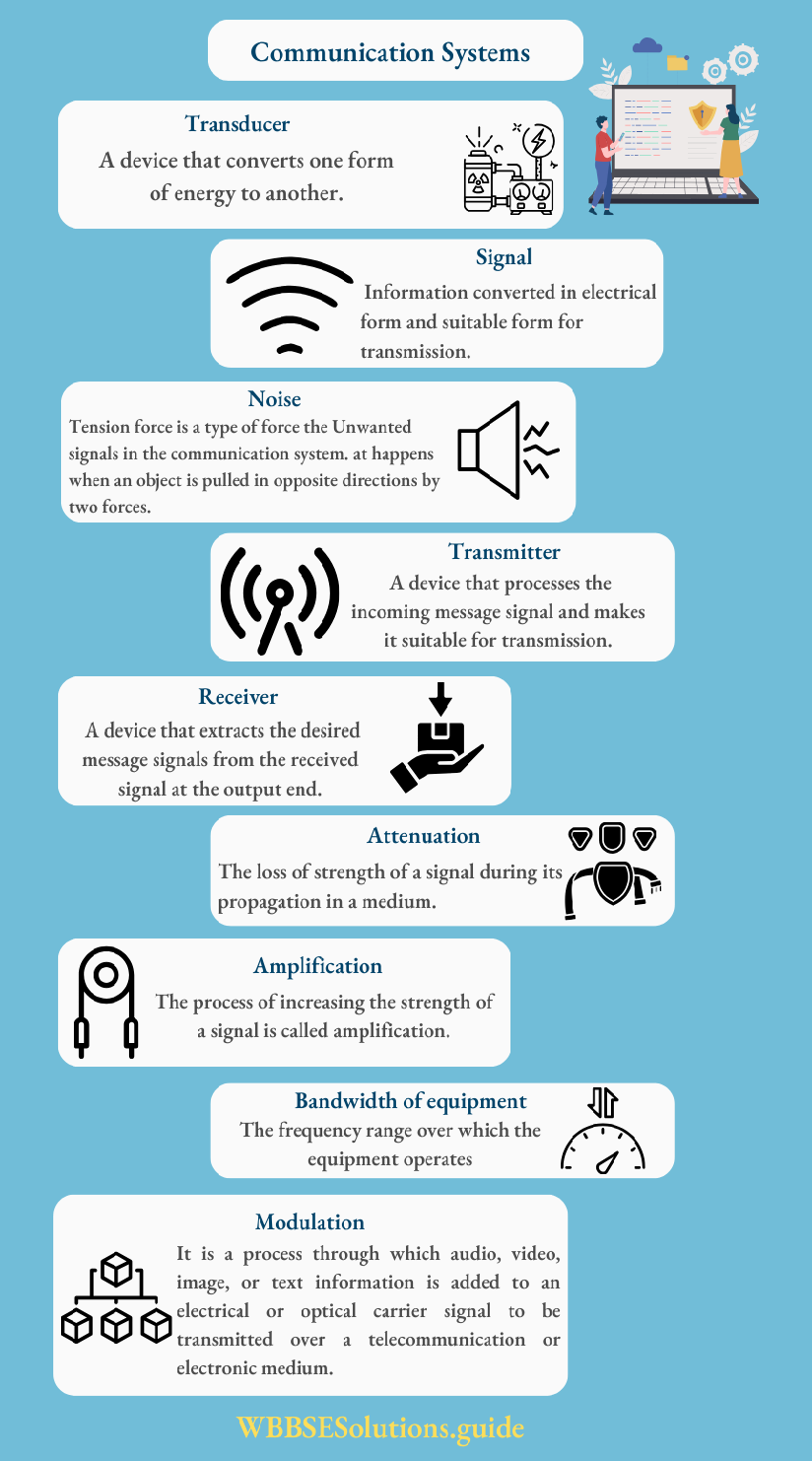NEET Physics Communication Systems Notes
Communication Systems
- Communication is the act of transmission of information.
- Every communication system has three essential elements transmitter, medium/channel, and receiver.
- There are two basic modes of communication:
- Point to point
- Broadcast
Satellite Communication and its Applications NEET Questions
Basic Terminology Used in Communication Systems

Read And Learn More: NEET Physics Notes
- A repeater is a combination of a receiver and a transmitter.
- The frequency range of speech signals 300Hz to 3100Hz
- Bandwidth of speech signals = (3100 – 300)Hz = 2800Hz
- The audible range of frequencies extends from 20Hz to 20kHz.
- To radiate signals with very high efficiency the antennas should have a size at least \(\frac{\lambda}{4}\)
- The attenuation of ground waves increases very rapidly with an increase in frequency
- From a few MHz to 30MHz, long-distance communication is made possible using ionospheric reflection.
- E.M. waves of frequencies greater than 30MHz penetrate the atmosphere and go to space. Hence they can be used in space wave propagation or line of sight communication (LOS).
Radio Horizon of the Transmitting Antenna
NEET Physics Communication Systems Important Questions
\(\mathrm{d}_{\mathrm{T}}=\sqrt{2 \mathrm{Rh}_{\mathrm{T}}}\)Maximum line of sight distance between two antennas having heights hT and hR above the earth is given by,
\(\mathrm{d}_{\mathrm{M}}=\sqrt{2 \mathrm{Rh}_{\mathrm{T}}}+\sqrt{2 \mathrm{Rh}_{\mathrm{R}}}\)The power radiated by the antenna is proportional to
\(\mathrm{P} \propto \frac{1}{\lambda^2}\)Communication Systems NCERT Summary for NEET
Amplitude modulation: The process of varying the amplitude of the carrier wave according to the variations of the modulating signal, without changing the frequency and phase of the carrier is called amplitude modulation.
Carrier wave,
\(c(t)=A_c \sin \left(\omega_c t\right)\)Modulating signal,
\(m(t)=A_m \sin \left(\omega_m t\right)\)Modulated wave,
\(c_m(t)=\left(A_c+A_m \sin \omega_m t\right) \sin \omega_c t\) \(c_m(t)=A_c\left(1+\frac{A_m}{A_c} \sin \omega_m t\right) \sin \omega_c t\) \(c_m(t)=A_c \sin \omega_c t+\frac{\mu A_c}{2} \cos \left(\omega_c-\omega_m\right) t-\frac{\mu A_c}{2} \cos \left(\omega_c+\omega_m\right) t\)where,
Concept of Signal Bandwidth and Noise in Communication Systems
\(\omega_{\mathrm{c}}-\omega_{\mathrm{m}}\) is called lower side band frequency.
\(\omega_c+\omega_m\) is called upper side band frequency.
\(\mu=\frac{A_m}{A_c}\) is called modulation index.
The difference in upper sideband frequency (USB) and lower sideband frequency (LSB) is called bandwidth.
\(\text { i.e., } \mathrm{B} \cdot \mathrm{W}=\left(\omega_{\mathrm{c}}+\omega_{\mathrm{m}}\right)-\left(\omega_c-\omega_{\mathrm{m}}\right)
B. W=2 \omega_{\mathrm{m}}\)
